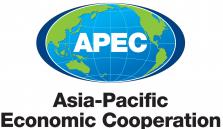 Comprised of 21 “member economies,” the APEC forum operates on the basis of non-binding commitments. APEC economies include the United States; Australia; Brunei; Canada; Chile; China; Hong Kong, China; Indonesia; Japan; Korea; Malaysia; Mexico; New Zealand; Papua New Guinea; Peru; Philippines; Russia; Singapore; Chinese Taipei; Thailand; and Vietnam.
Comprised of 21 “member economies,” the APEC forum operates on the basis of non-binding commitments. APEC economies include the United States; Australia; Brunei; Canada; Chile; China; Hong Kong, China; Indonesia; Japan; Korea; Malaysia; Mexico; New Zealand; Papua New Guinea; Peru; Philippines; Russia; Singapore; Chinese Taipei; Thailand; and Vietnam.
The Putrajaya Vision 2040 defines APEC’s strategic vision of priorities to deliver a free, open, fair, non-discriminatory, transparent, and predictable trade and investment environment in the Asia-Pacific. This vision was adopted by Leaders in 2020.
Decisions made within APEC are reached by consensus and commitments are undertaken on a voluntary basis. APEC has contributed to the reduction of barriers to trade in the region over time, leading to the expansion of economic growth and international trade.
Advancing Free and Fair Trade through APEC
USTR represents the United States on critical trade and investment initiatives at APEC, with the goal of delivering for U.S. exporters concrete and meaningful results that break down barriers to trade in the Asia-Pacific, create jobs, and contribute to economic growth.
APEC Trade Summary
U.S. goods trade with APEC economies totaled an estimated $3.4 trillion in 2024. U.S. goods exports to APEC in 2024 were $1.2 trillion, up 2.2 percent ($26.6 billion) from 2023. U.S. goods imports from APEC totaled $2.1 trillion in 2024, up 6.1 percent ($124.3 billion) from 2023. The U.S. goods trade deficit with APEC was $913.1 billion in 2024, a 12.0 percent increase ($97.7 billion) over 2023.
U.S. Trade and Investment Initiatives at APEC
USTR represents the United States on critical trade and investment initiatives at APEC, with the goal to advance free and fair trade in the region, deliver for U.S. exporters concrete and meaningful results that break down barriers to trade in the Asia-Pacific, and create jobs. U.S. trade priorities in APEC include:
• Promoting the adoption of high-standard, market-opening actions to eliminate barriers to trade and investment, and addressing trade distorting and other unfair practices;
• Reducing barriers to digital trade to support innovation and the growth;
• Promoting transparency with respect to trade practices;
• Increasing services competitiveness in the region by lowering barriers that impede U.S. services exports;
• Raising standards for the protection and enforcement of intellectual property in the region;
• Promoting good regulatory practices in such areas as public consultations, assessing the impact of regulations, and internal coordination of rule-making;
• Promoting regulatory cooperation in key sectors such as chemicals, life sciences, and autos; and
• Reducing transaction costs for U.S. businesses through facilitating implementation of the WTO Agreement on Trade Facilitation across all APEC economies through capacity building projects and public-private engagement.
Additional Resources:




